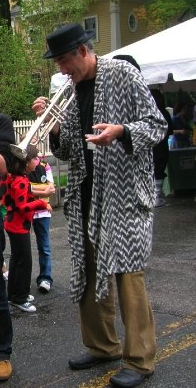
 Now, ladies and gents, the promised jazz cage scrap between Fletcher 'Hatchet' Henderson and 'Grapplin' Guy Lombardo, or should we say, the familias Henderson and Lombardo. It's tag team, as both come brothered-up, but Fletcher and Horace are outgunned by the Lombardo mob: Guy, Carmen, Liebert and Victor.
Now, ladies and gents, the promised jazz cage scrap between Fletcher 'Hatchet' Henderson and 'Grapplin' Guy Lombardo, or should we say, the familias Henderson and Lombardo. It's tag team, as both come brothered-up, but Fletcher and Horace are outgunned by the Lombardo mob: Guy, Carmen, Liebert and Victor.
Henderson does higher ed. and pledges Alpha Phi Alpha at Atlanta U. At the same time, the Lombardos rehearse a grammar school orchestra in the back of their dad's tailor shop. That puts them ahead in the early rounds, as they turn pro in the teens.
Henderson, however, comes on strong and is the first to score in NYC, forming an orchestra in 1922 and getting good gigs at Club Alabam and the Roseland.
The sweet and hot waters are muddy.
Henderson's arrangements at this point are as much Whiteman as anything else. His is a social dance band with a blues tinge. Meanwhile, Lombardo records for jazz label Gennett in early 1924 and there's not a hell of a lot of difference between those recordings and early Henderson.
Late 1924 marks the real split. The Lombardo boys start "The Royal Canadians" and Louis Armstrong joins the Henderson crowd.
First knockdown goes to the Royal Canadians, as they implement a strong PR strategy, using the tag line: "The Sweetest Music This Side of Heaven." Even if the sobriquet 'sweet' has been in general use, it starts to get burnished to a high cultural gleam by the Royal Canadians.
When Armstrong joins Henderson in 1924, he brings the heat. Henderson and fellow arranger Don Redman respond by creating arrangements that allow the Armstrong fire to shine in a large ensemble context. Soloists like Hawkins hear Louis and join the fray.
As the boys in the quarterlies would say, this is the juncture at which Henderson and Lombardo self-differentiate; in the process, creating more distinguishable sweet and hot streams in popular music.
A quick retrospective follow-up reveals the following: Henderson's band nurtured jazz stars and the new idea of what large-ensemble jazz arranging could be. He couldn't keep the band together and mostly lived off arrangements he'd originally done for his 20's band that the Goodman band scored big with a decade later.
The Royal Canadians go on to sell somewhere between 100-300 million records and become the musical face of New Year's Eve in America.
Just sayin'.
Next Time on JazzGrudgeMatch2010@: All in the Family-"Dorsey vs. Dorsey."
 Some have castigated the recent alliance between Sony and the Miles Davis estate which offers "A mouthpiece replica of exactly the 'Gustat' Heim 2 model used by Davis especially created by Kanstul," t-shirts and other fascinating items. They even throw in 43 cd's.
In fact, those corporate giants don't go nearly far enough in offering a package that can truly bring fans closer to their favorite artists. I have therefore forged a metaheuristic liaison with certain Ukranian businessmen and am delighted to be able to offer the Deluxe Louis Armstrong Simulacrum Kit, composed of:
Some have castigated the recent alliance between Sony and the Miles Davis estate which offers "A mouthpiece replica of exactly the 'Gustat' Heim 2 model used by Davis especially created by Kanstul," t-shirts and other fascinating items. They even throw in 43 cd's.
In fact, those corporate giants don't go nearly far enough in offering a package that can truly bring fans closer to their favorite artists. I have therefore forged a metaheuristic liaison with certain Ukranian businessmen and am delighted to be able to offer the Deluxe Louis Armstrong Simulacrum Kit, composed of:
 So act now. Our 'operators' are standing by.
It's not re-animation, but it's pretty damn close.
So act now. Our 'operators' are standing by.
It's not re-animation, but it's pretty damn close.






















